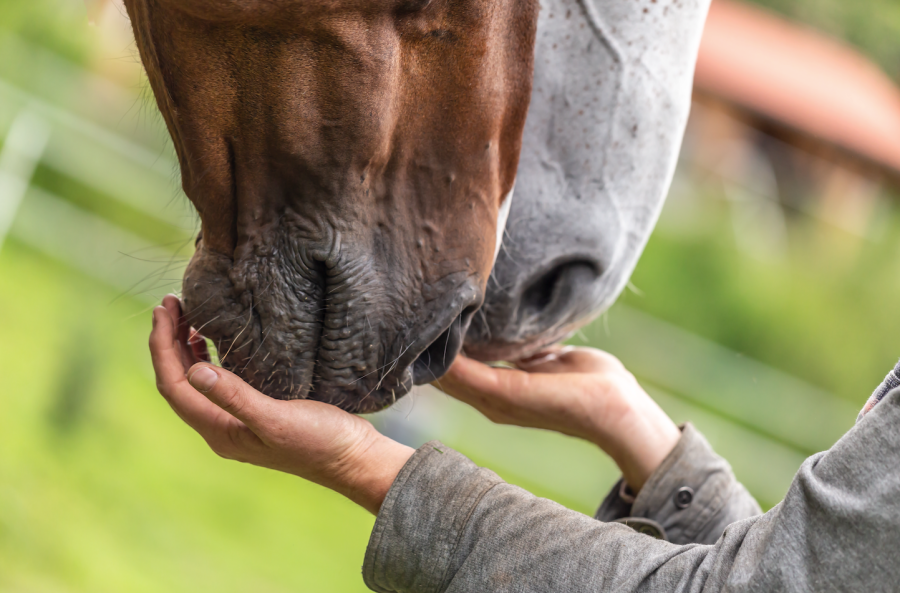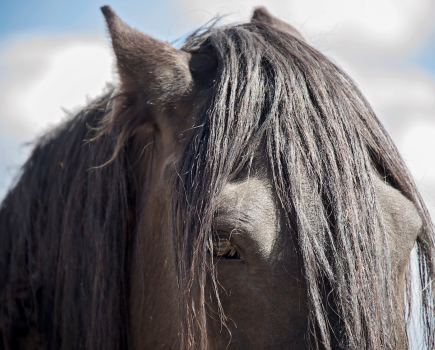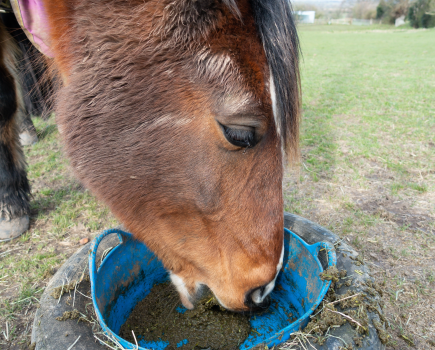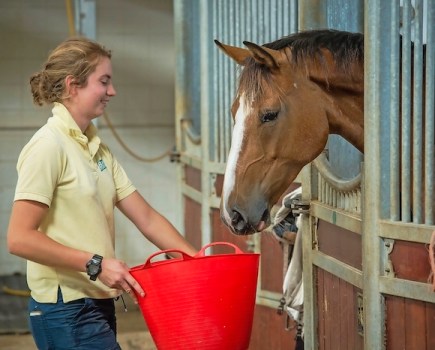In times where every penny counts, you may find yourself asking the question: is there such a thing as cheap horse feed? However, it’s less about the price tag and more about what’s inside the bag and how you feed it that really counts.
We all want to do the best for our horses and that means providing them with a correct diet that fulfils all their nutritional needs. It is possible to do this while finding ways to save money on horse feed — you just need to know what you’re looking for.
While a big feed bill has its roots in good intentions, it could be that you’re doing neither your wallet nor your horse much good…
Cheap horse feed
I haven’t got a magic list of cheap horse feed to share. However, the feed industry is a big one. There are numerous companies making chaffs, cubes, mixed feeds and supplements with similar ingredients claiming to achieve the same results.
So it pays to shop around. What one manufacturer charges for a chaff with added oil may not be the same as another, and a few pennies saved here and there soon adds up.
Don’t automatically assume, however, that the feed you have chosen has saved you a few pounds because it is cheap compared to another version that, from a quick perusal of the front of the bag, looks to be the same thing.
What quantity does it say you should feed the cheaper of the two in? Is the ingredients list (and volume of each) like for like?
It could be that you have to feed more of the cheap horse feed to provide a balanced diet, or it might be missing vital ingredients and so you have to add a balancer or supplement too. Paying less can actually be a false economy.
Budget alternatives
“Most horse feeds from manufacturers contain similar, if not the same, ingredients,” confirms Saracen nutritionist Stephanie George BSc (Hons).
“It’s all about how those ingredients are combined and at what inclusion rate — that’s what gives each feed its individual characteristics.
“Some chaff-based products are fortified, which can make them more expensive. If you’re already feeding a balanced diet and adding chaff as extra, it could be more cost effective to use a non-fortified product.
“Some feed merchants will have their own brand range, usually made for them by a feed manufacturer to meet certain specifications.
“But in terms of whether this is value for money or not really depends on what you’re wanting to achieve,” continues Stephanie.
“Feeding a cheap alternative, such as a horse feed that is unbranded or not targeted to specific nutritional needs, may fall short of your desired outcome.
“So in the end, you may find that you’re increasing the feeding rates to compensate and therefore need to buy more, so it’s not actually a cheap horse feed in the long run.”
Cheap horse feed: shop locally
If you want to keep the cost as cheap as possible, being savvy about where you buy is as important as choosing a feed that is best suited to your individual horse.
Miles travelled to pick up a bag of horse feed adds to the cost, because fuel isn’t cheap. Providing you have somewhere dry and safe from mice and rats to store bags of feed, you could buy it in bulk so that you have to drive to the store less frequently.
Or pick it up on your way home from work rather than making a special trip.
If you’re on a livery yard, buddy up with other owners to take it turns buying feed in one shop for all the horses rather than each of you driving to the feed store individually. All of this helps cut costs too.
My friend, who had two ponies in light hacking work and fed a mix from Mole Valley Farmers, used to add a few bags to her father’s cattle feed order.
Clever, I thought, because ultimately the best way to make horse feed cheap is by not paying for it yourself!
Overfeed = overspend
You can’t dump a scoop of this and a scoop of that in your horse’s feed bucket and hope for the best. It’s crucial to ensure that your horse is receiving the right type and amount of feed, alongside their daily forage.
Guidelines on the backs of feed bags can be quite broad, though, and this often leads to overfeeding. Unfortunately in this situation, this also means overspending. This is not conducive to saving money on horse feed.
“Feed bags will offer a guide as to how much to feed your horse, but companies keep these guidelines broad to avoid overwhelming owners with information and to ensure they cover all classes of horses that the product could be used for,” explains Stephanie.
“In order to ensure accurate feeding rates for an individual horse, it’s best to call the manufacturer’s nutritional helpline.”
Portion size
Regular body condition scoring can help you to monitor your horse’s weight and avoid feeding portions that are too big.
Keeping unnecessary weight gain and unwanted fizziness at bay, while making your bags of feed last longer, is a win-win situation and the best way of making horse feed ‘cheap’ — or at least cheaper.
Your horse’s workload should be taken into account too.
If your horse is not very active, seek advice from a nutritionist on how to adjust their intake so that you provide a balanced diet, but not too many calories.
Bear in mind that if your horse is in hard work but is injured or requires time off for some reason, you’ll need to adjust what’s in their bucket too.
This is not only best for their general health, but better for your bank balance too.
Don’t double up on ingredients
It might not be necessary to feed a supplement if you’re already feeding the recommended amounts of hard feed to your horse. Understanding this is an easy way to save money on horse feed in your quest to making it cheap.
“Many feeds are already fully fortified. This means that when fed at the recommended intake, they will provide the horse with all the vitamins and minerals they require and feeding additional balancers or supplements won’t be necessary,” says Stephanie.
“When doubling up on vitamins and minerals in particular, horses will simply excrete what they don’t need, meaning your money is literally being wasted.”
There are, of course, circumstances when balancers or supplements are advisable, such as for horses on a forage-only diet or those who do not receive the recommended amount of feed because they may be missing out on essential nutrients.
It’s down to you as the owner to make sure you are aware of your horse’s special requirements and to feed (and therefore spend) accordingly.
Your best bet is to speak to a nutritionist for advice. Every feed company has a number or email address for you to easily make contact. I do this a lot. There’s no obligation to buy their feed either, so don’t worry about that.
Store feed correctly
Make sure wherever you keep your horse’s feed is equipped to store it properly.
Even if the horse feed was cheap to buy, it’s a complete waste of money should it get wet or be attacked by vermin, as you’ll have to throw it away.
When you’re trying to save money on horse feed, wasting it through poor storage is something you need to avoid.
“Feed packaging will indicate how an individual project is best stored, so you can reduce wastage by ensuring feed lasts longer,” advises Stephanie.
“Usually, this will mean a cool, dry environment where it’s protected from contamination by rodents. Transfer feed to a sealed plastic or metal bin rather than leaving it in bags that can be climbed into or bitten through.
Buy in bulk
“Buying and storing feed in bulk can also help to reduce the cost if discounts are available for this. However, storage conditions need to be taken into consideration as well as the use-by date to ensure the vitamins and minerals within the product remain viable,” adds Stephanie.
I’ve kept horse feed in a few places over the years, including iron dustbins with heavy lids and plastic wheelie bins (with something heavy on top to keep the lid weighted down and closed).
My best feed bin was a heavy duty large, purpose-made iron bin that would have made me cry (or curse!) should I catch my fingers underneath the lid when closing it (thankfully, I never did).
There are plenty on the market, like this one, and it’s worth investing if you can. They aren’t cheap, but they do a great job of keeping horse feed safe and secure, even if used outside.
If you run out of room in your feed bin, at the very least make sure your bag is stored off the floor. Considering that rats can climb pretty well, though, it won’t be safe up there for long.
Cubes vs straights
Some owners opt for ‘straights’ as a cheap alternative to ready-mixed horse feeds. Feeding straights allows you to know exactly what’s in your horse’s bucket, but their use comes with a caution.
“Straights in themselves are not nutritionally balanced. Therefore, we would not recommend them as the sole concentrate source without also feeding a balancer, consequently upping the feeding cost anyway,” warns Stephanie.
“Complete feeds are fully balanced already and manufacturers have taken into account the ratios of vitamins and minerals required to balance a cereal-based diet. Therefore it’s simpler — and maybe cheaper in the long run — to feed a mix or cube instead in order to give your horse a balanced diet.”
Quality ingredients
Check the contents of the feed you’re considering to buy and go for quality ingredients that can be fed in lower volumes.
Stephanie says: “This is true. For example, fibre ingredients such as alfalfa, soya hulls and beet pulp (‘super fibre’ sources) provide a higher energy (calorie) intake when compared to other fibre ingredients such as wheat feed and oat feed.
“The higher energy intake provided by the super fibres will mean that you can feed less.”
Slow down speedy eaters
It’s not just horse feed that is expensive rather than cheap, forage is too — and as this must be the core of every horse and pony’s diets, you need to feed a lot of it.
Double netting will make forage like hay and haylage last longer, because it is harder for your horse to eat and therefore their consumption slows down.
This is a good tactic if your horse or pony is a good doer and so you need to make their ration last longer. You want to avoid them standing in their stable with nothing to eat.
However, double netting isn’t suitable for every horse, particularly one who needs to gain weight or struggles to hold their condition, such as veterans.
“Feeding forage ad-lib is what a horse’s digestive system needs to stay healthy, therefore ‘over-feeding’ of forage isn’t an issue unless you have a very good doer that’s prone to excess weight gain and its associated health issues,” advises Stephanie.
Electrolytes or table salt?
Adding electrolytes to horse feed is particularly relevant when feeding a horse in the summer, because horses sweat more in hot weather.
They are unlikely to be needed all-year round, though, in countries that have hot and cold seasons like the UK. Continuing to feed electrolytes when it’s cold could mean wasting your money.
There are several electrolytes on the market, or some people add table salt to horse feed instead because it is cheap and does the same job.
“Sweat mainly comprises of sodium and chloride, which is what table salt is made from,” confirms Stephanie, who is a nutrition advisor at Saracen Horse Feeds.
“You only need to feed an electrolyte supplement when a horse is sweating heavily to replenish the potassium, magnesium and calcium that are lost in much smaller quantities.”
Don’t be tempted by other animal feeds
Sheep and cattle nuts are cheap — certainly when compared to a lot of horse feed anyway. Even though they look the same and come with a tempting lower price tag, never ever give a feed intended for a different animal to your horse.
Ultimately this will cost you dearly, and puts your horse’s life at risk.
Horses have complex digestive systems and if you feed something that is not specifically designed to be eaten by them, you’re likely to end up with a hefty emergency vet bill for colic.
“Sheep feed, for example, has been formulated specifically for the needs of sheep and not equines. Sheep are also very sensitive to copper so these feeds contain copper antagonists, which could cause deficiencies in horses,” warns Stephanie.
Main image © Shutterstock









